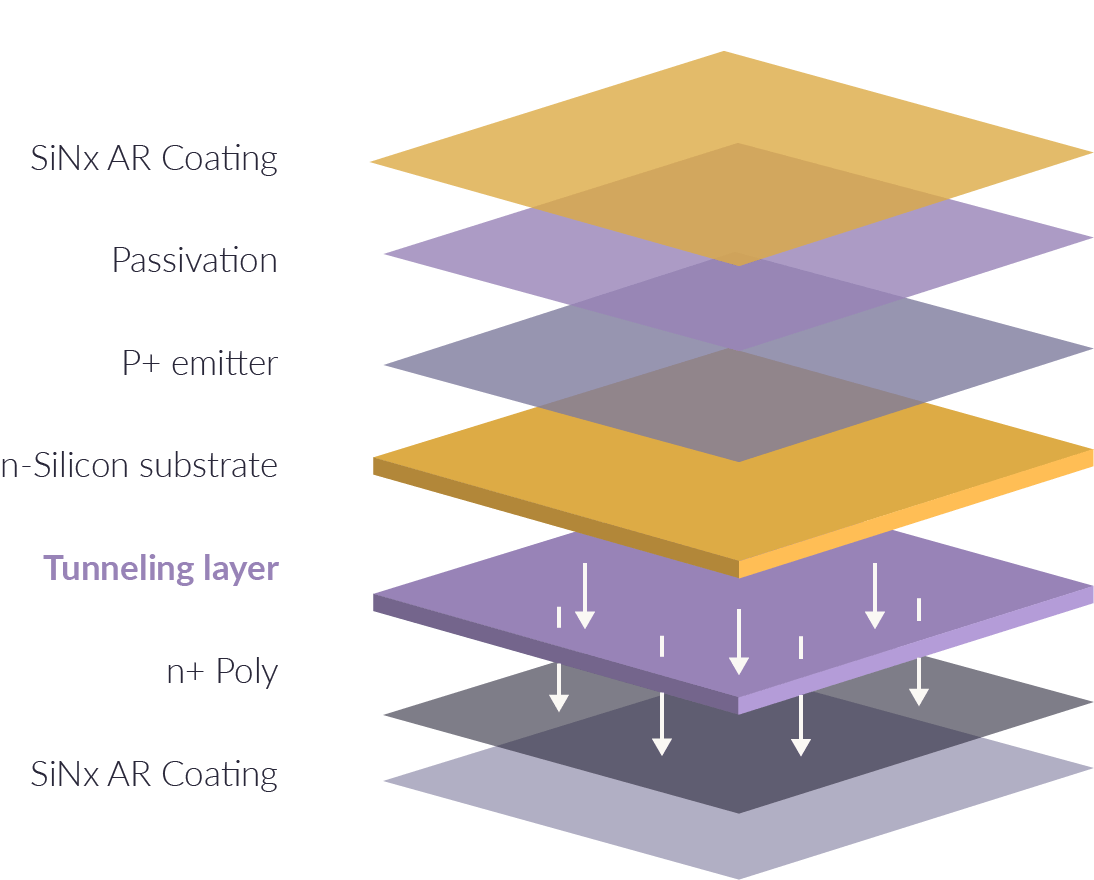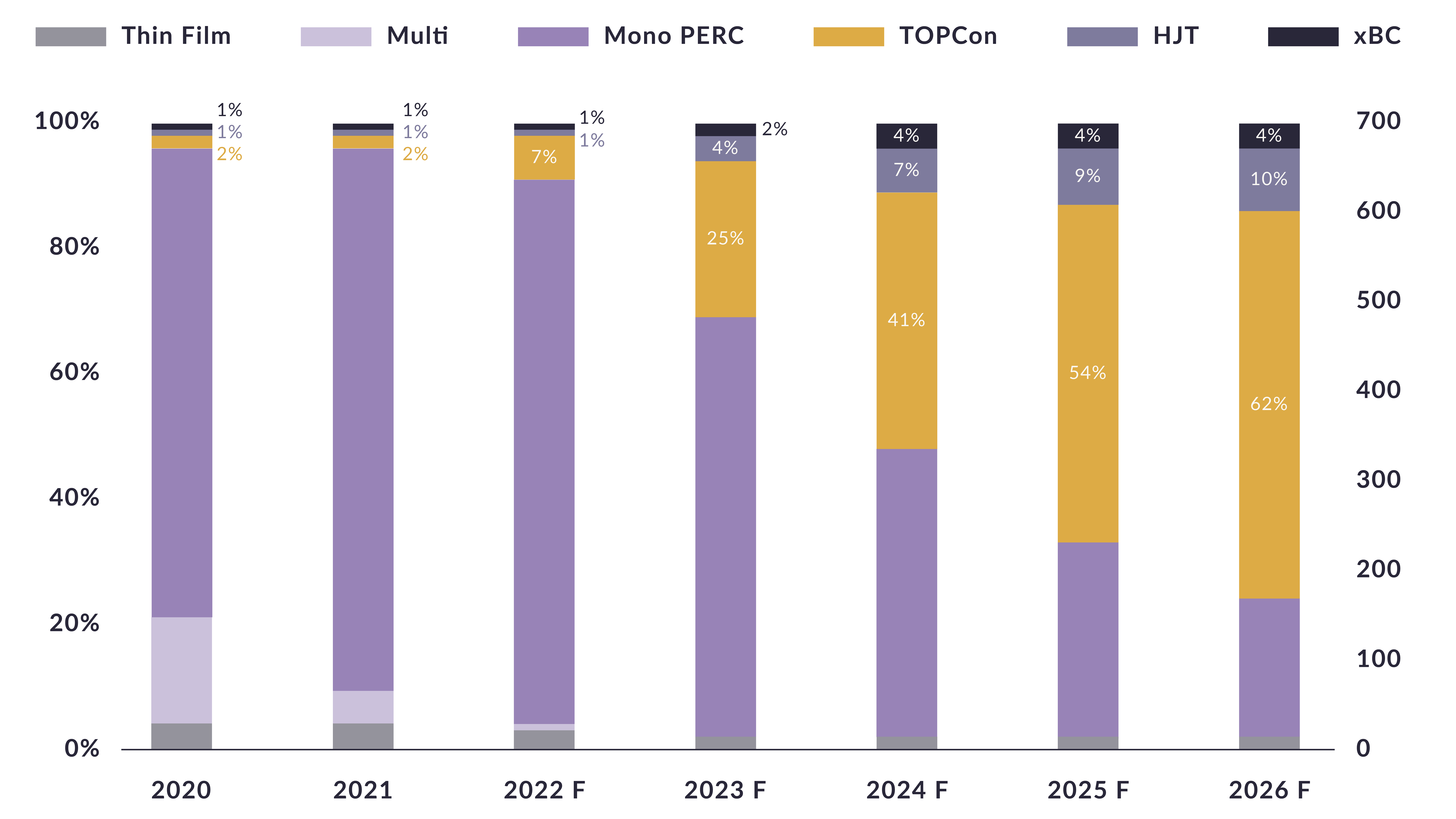The best combination of efficiency and reliability relative to capital cost. Is that so? TOPCon Technology, or Tunnel Oxide Passivated Contact, was first introduced in the industry in 2013 by a group of German researchers (Fraunhofer Institute for Solar Energy Systems).
It is a type of solar panel technology that aims to improve the efficiency of solar cells. Traditional solar cells use metal contacts to collect the electricity generated by the cell. The issue with that is, these contacts can also block some of the incoming light. That leads to a reduction in efficiency of the cell.
TOPCon technology addresses this problem by using a thin layer of insulating material (a tunneling oxide layer) between the metal contact and the solar cell. This layer creates a tunneling junction that allows for better electron transport and collection, resulting in higher cell efficiencies. Thanks to the passivation of the cell surface with a thin layer of silicon oxide, the rate of electron recombination is also reduced. TOPCon solar panels therefore also perform better in low-light conditions. This makes them ideal for use in areas with less sunlight, such as cloudy or shaded regions.
The thin oxide layer also protects the cell from extreme environmental factors, such as moisture and temperature fluctuations, that can generally cause degradation. This also means that the technology ensures a higher durability, since they are less susceptible to degradation over time.
The best combination of efficiency and reliability relative to capital cost. Is that so? TOPCon Technology, or Tunnel Oxide Passivated Contact, was first introduced in the industry in 2013 by a group of German researchers (Fraunhofer Institute for Solar Energy Systems).
It is a type of solar panel technology that aims to improve the efficiency of solar cells. Traditional solar cells use metal contacts to collect the electricity generated by the cell. The issue with that is, these contacts can also block some of the incoming light. That leads to a reduction in efficiency of the cell.
TOPCon technology addresses this problem by using a thin layer of insulating material (a tunneling oxide layer) between the metal contact and the solar cell. This layer creates a tunneling junction that allows for better electron transport and collection, resulting in higher cell efficiencies. Thanks to the passivation of the cell surface with a thin layer of silicon oxide, the rate of electron recombination is also reduced. TOPCon solar panels therefore also perform better in low-light conditions. This makes them ideal for use in areas with less sunlight, such as cloudy or shaded regions.
The thin oxide layer also protects the cell from extreme environmental factors, such as moisture and temperature fluctuations, that can generally cause degradation. This also means that the technology ensures a higher durability, since they are less susceptible to degradation over time.
Today, the focus in the solar energy industry is mainly on P-type (PERC) technology, but as forecasts and experts all around the world suggest, we are clearly in a transition towards N-type technologies (HJT, IBC, and TOPCon). Although it is clear that IBC and HJT are very interesting technologies in terms of efficiency, they are not so in terms of compatibility, as mentioned before. The investment cost of these technologies is much higher than for TOPCon because it requires a completely new production line. The complex manufacturing procedures are not compatible with the current industry, making the transition anything but smoothly or budget-friendly. Precisely because the current industry is so focused on PERC technology and the benefits in terms of efficiency, it’s a much more logical step for the industry to switch to TOPCon. A step we’ve already taken!
The current ruling technology in the solar power industry, using a passivated film to the back of the solar cells in order to absorb more light.
TOPCon can in fact use that same PERC film, but add the tunneling oxide layer on top to contain unabsorbed light and reduce recombination losses. So in only a few extra steps, TOPCon succeeds in transforming a PERC solar cell into one that is significantly more efficient. That’s why this technology has the lowest net-capital cost at full scale. It can be added to existing PERC lines rather easily, without changing the production process too much.
This technology combines the benefits of two different types of solar cells into one high-power hybrid solar cell: crystalline silicon and amorphous silicon thin-film. They are made up of thin layers of n-type and p-type silicon and a thin layer of amorphous silicon in between, acting as an intrinsic layer. This results in higher conversion efficiencies and lower recombination rates.
While HJT is said to surpass the performance of PERC technology, it requires a completely different manufacturing process. And since PERC is currently the most ubiquitous technology in the solar industry, it’s not that easy to transition.
The TOPCon technology provides the industry with a solution, since these panels perform better in terms of efficiency, cost, durability, temperature sensitivity, and manufacturing scalability.
These solar panels utilize a unique design to increase their energy efficiency. The main difference is that they have their electrical contacts placed on the back of the cell. The result? It maximizes the amount of sunlight that hits the front of the panel. IBC solar panels also use a unique interdigitated design: the positive and negative electrical contacts are interlaced with each other, which allows for a more even distribution of current across the panel. This reduces energy losses and increases the overall efficiency of the panel. IBC solar panels are commonly used in high-performance residential and commercial solar installations, as well as in research and development applications.
Research has shown that the energy yield performance of TOPCon bifacial modules still outperform IBC solar panels, thanks to the higher bifacial rate and lower working temperature.

The industry forecast also clearly shows this. TOPCon will account for approximately 25% of the total industry in 2023. It is expected that the technology will grow tremendously in the coming years, up to 62% in 2026. However, IBC remains lagging behind at 4%, due to the scalability drawbacks. The same goes for HJT. Although the share of this technology is expected to grow to 10%, the growth process remains limited.
In this N-Type era, it’s better to focus on one direction: TOPCon. Therefore, our research and development process will not focus on other technologies, but our focus will simultaneously shift to perovskite technology in the next era.
Perovskite solar panels are a new and exciting technology in the field of solar energy. These solar panels use perovskite materials as their active layer, which have shown great promise due to their high efficiency, low cost, and ease of manufacturing.Perovskite solar panels therefore have the potential to revolutionize the solar energy industry. To be continued…
